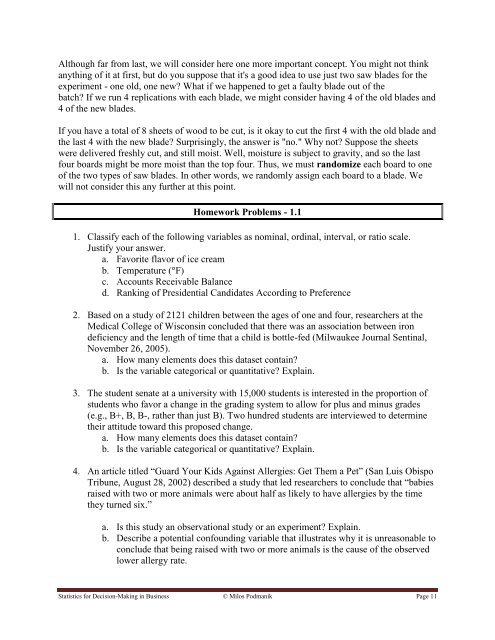Statistics for Decision- Making in Business - Maricopa Community ...
Statistics for Decision- Making in Business - Maricopa Community ...
Statistics for Decision- Making in Business - Maricopa Community ...
Create successful ePaper yourself
Turn your PDF publications into a flip-book with our unique Google optimized e-Paper software.
Although far from last, we will consider here one more important concept. You might not th<strong>in</strong>k<br />
anyth<strong>in</strong>g of it at first, but do you suppose that it's a good idea to use just two saw blades <strong>for</strong> the<br />
experiment - one old, one new What if we happened to get a faulty blade out of the<br />
batch If we run 4 replications with each blade, we might consider hav<strong>in</strong>g 4 of the old blades and<br />
4 of the new blades.<br />
If you have a total of 8 sheets of wood to be cut, is it okay to cut the first 4 with the old blade and<br />
the last 4 with the new blade Surpris<strong>in</strong>gly, the answer is "no." Why not Suppose the sheets<br />
were delivered freshly cut, and still moist. Well, moisture is subject to gravity, and so the last<br />
four boards might be more moist than the top four. Thus, we must randomize each board to one<br />
of the two types of saw blades. In other words, we randomly assign each board to a blade. We<br />
will not consider this any further at this po<strong>in</strong>t.<br />
Homework Problems - 1.1<br />
1. Classify each of the follow<strong>in</strong>g variables as nom<strong>in</strong>al, ord<strong>in</strong>al, <strong>in</strong>terval, or ratio scale.<br />
Justify your answer.<br />
a. Favorite flavor of ice cream<br />
b. Temperature ( F)<br />
c. Accounts Receivable Balance<br />
d. Rank<strong>in</strong>g of Presidential Candidates Accord<strong>in</strong>g to Preference<br />
2. Based on a study of 2121 children between the ages of one and four, researchers at the<br />
Medical College of Wiscons<strong>in</strong> concluded that there was an association between iron<br />
deficiency and the length of time that a child is bottle-fed (Milwaukee Journal Sent<strong>in</strong>al,<br />
November 26, 2005).<br />
a. How many elements does this dataset conta<strong>in</strong><br />
b. Is the variable categorical or quantitative Expla<strong>in</strong>.<br />
3. The student senate at a university with 15,000 students is <strong>in</strong>terested <strong>in</strong> the proportion of<br />
students who favor a change <strong>in</strong> the grad<strong>in</strong>g system to allow <strong>for</strong> plus and m<strong>in</strong>us grades<br />
(e.g., B+, B, B-, rather than just B). Two hundred students are <strong>in</strong>terviewed to determ<strong>in</strong>e<br />
their attitude toward this proposed change.<br />
a. How many elements does this dataset conta<strong>in</strong><br />
b. Is the variable categorical or quantitative Expla<strong>in</strong>.<br />
4. An article titled “Guard Your Kids Aga<strong>in</strong>st Allergies: Get Them a Pet” (San Luis Obispo<br />
Tribune, August 28, 2002) described a study that led researchers to conclude that “babies<br />
raised with two or more animals were about half as likely to have allergies by the time<br />
they turned six.”<br />
a. Is this study an observational study or an experiment Expla<strong>in</strong>.<br />
b. Describe a potential confound<strong>in</strong>g variable that illustrates why it is unreasonable to<br />
conclude that be<strong>in</strong>g raised with two or more animals is the cause of the observed<br />
lower allergy rate.<br />
<strong>Statistics</strong> <strong>for</strong> <strong>Decision</strong>-<strong>Mak<strong>in</strong>g</strong> <strong>in</strong> Bus<strong>in</strong>ess © Milos Podmanik Page 11
















